Manchester City travelled to the brand new Tottenham Hotspur stadium on Tuesday night in the quarter-finals of the Champions League. At this same stage last season, the English champions fell to another domestic rival in Liverpool. For Tottenham, this is the first time since the 2010-2011 season that they have reached this stage of the competition.
In the league Manchester City are 16 points ahead of Tottenham, beating them at Wembley and with a second encounter at the Etihad to come. However, when they met on Tuesday night there was very little to separate the two sides.
In our tactical analysis, we take a look at some of the key tactical decisions taken by Pep Guardiola which influenced the outcome of this game. We also look at how Tottenham were able to overcome Manchester City and take a first-leg lead to the Etihad.
Lineups
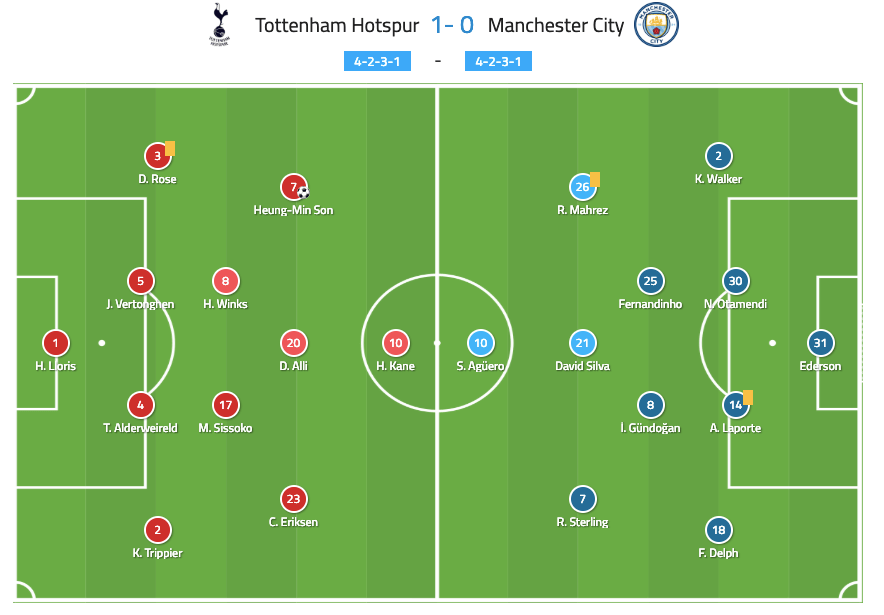
Both sides set-up in 4-2-3-1 formations. Tottenham have opted for this formation 10 times in the Premier League this season and six times in the Champions League. They are very accustomed to playing in this shape. Manchester City on the other only tend to turn to the 4-2-3-1 when they play in ‘big games’. The two times that Manchester City have used the 4-2-3-1 in the Premier League were both against Liverpool. This was the first time that City have gone with the 4-2-3-1 in Europe this season.
From Tottenham’s last game against Crystal Palace, Mauricio Pochettino made two changes. Ben Davies dropped out with Danny Rose returning at left-back. Dele Alli was returned to his usual position in the attacking midfield role with Harry Winks coming into the holding role.
Pep Guardiola made a couple of changes following his side’s FA Cup semi-final victory over Brighton on Saturday. Some of these changes were forced upon him. Bernardo Silva tweaked an injury in the hours leading up to kick-off so he was replaced by Riyad Mahrez.
Benjamin Mendy doesn’t appear to have the necessary physical capabilities to play more than one game per week and as such Fabian Delph made just his third start in 2019 at left-back. Kevin De Bruyne dropped out for Fernandinho and Sergio Agüero was reinstated up front in place of Gabriel Jesus.
Pep’s cautious tactics
The main talking point that has arisen in the aftermath of the game was Pep Guardiola’s decision to operate with two defensive midfielders instead of his usual duo of ‘free eights’. Kevin De Bruyne had been looking like something close to his best in his recent appearances for City and it was perhaps a surprise he dropped out of the side.
However, Guardiola’s intentions in this game were clear: draw 0-0. In previous Champions League ties, Guardiola and Manchester City have sometimes not assessed the situation well enough. Against Liverpool last season, Guardiola stuck to his principles in the first-leg and City were dismantled 3-0 at Anfield: tie over.
At his previous clubs, Guardiola has also had some damaging defeats in first legs away from home. A 3-1 defeat away to Inter Milan at the helm of Barcelona in the semi-finals was followed by a 3-1 defeat to Porto in the quarter-finals with Bayern Munich and then a 3-0 loss to Barcelona in the following round. All of these experiences have clearly shaped the way in which Guardiola approaches the first-legs of Champions League ties away from home.
Manchester City would usually set-up in a 4-3-3, with one defensive midfielder flanked by two inverted full-backs to control for the counter-attack. Ahead of them would be two free eights who can roam around and find space in the advanced half-spaces; something loosely resembling the following.
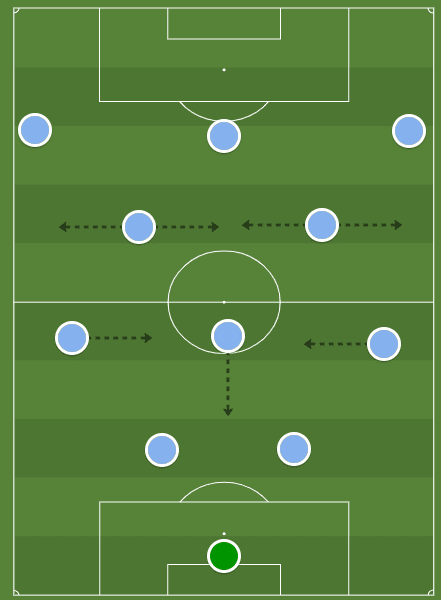
However in recent times, as mentioned above, Manchester City have lined up more like below.
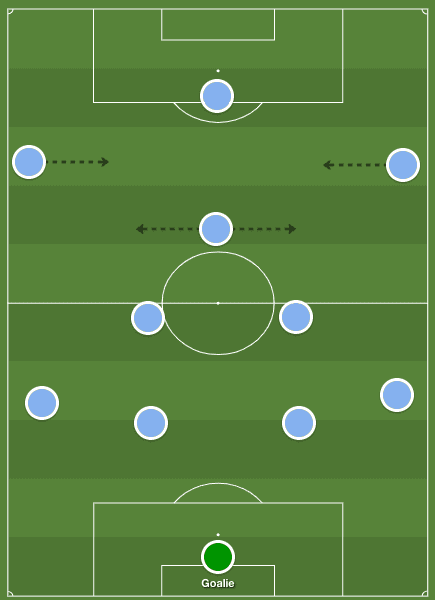
Guardiola has often referred to Champions League knockout games as being 180 minutes. This slight alteration in tactics is clearly designed to prevent the tie being over after the first 90 minutes, as it so often has been in his career. Whether this is the correct approach remains to be seen.
However, a number of problems arose for Manchester City in their build-up due to this setup. With a 33-year-old David Silva tasked with operating in attacking midfield on his own, he often found himself on the opposite side from where the ball was.
In the image below we can see that there is actually quite a lot of space for Manchester City to exploit in the left-half space. However, there is no-one occupying it. Ilkay Gündoğan is under strict instructions to stay next to Fernandinho and as such isn’t instructed to occupy that space.
In Manchester City’s usual setup David Silva would be in a position to occupy this space as he would usually be the left-hand side number eight, with De Bruyne, Bernardo Silva or Gündoğan on the right-hand side. Laporte is presented with almost no options where he would usually have a number available.
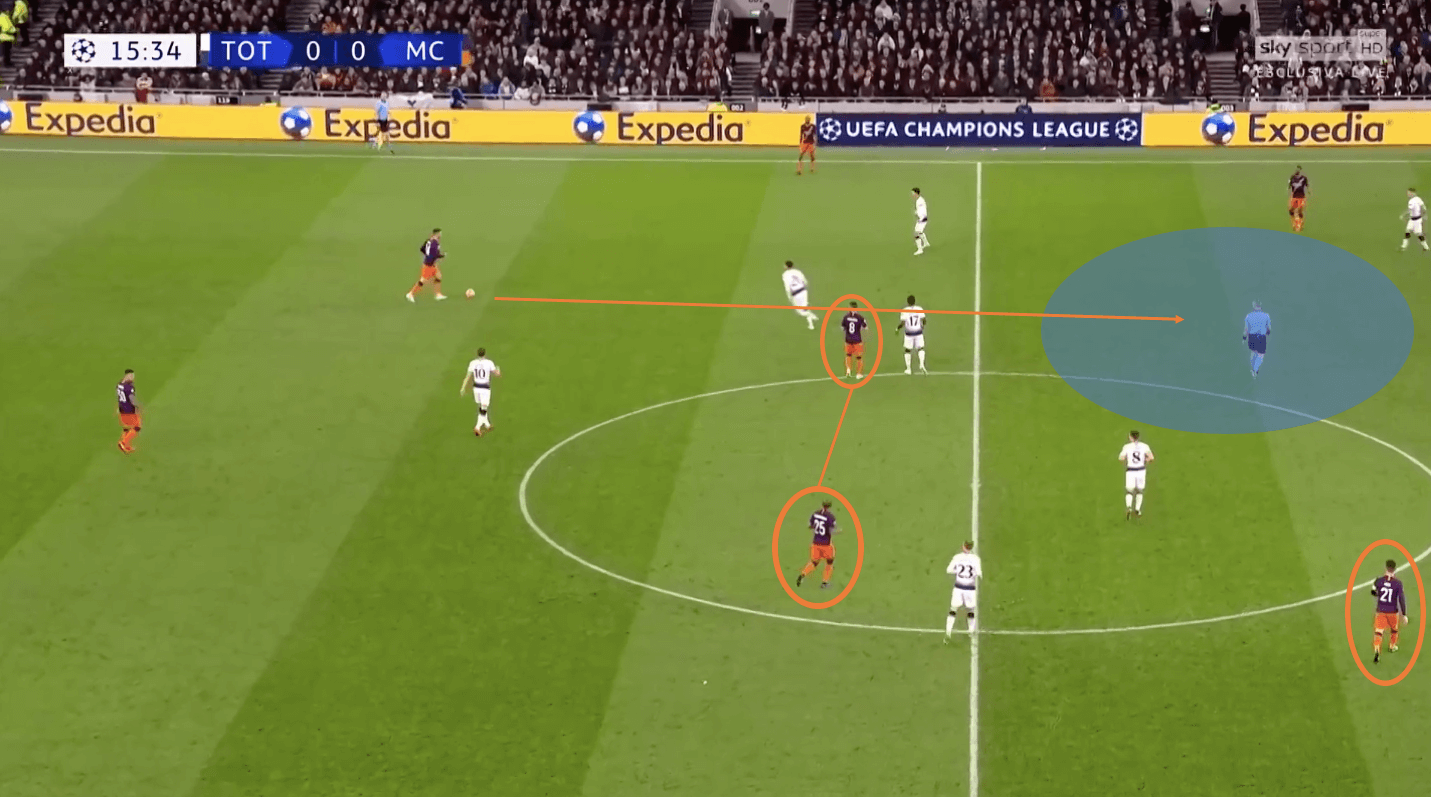
A similar situation can be seen below. David Silva is again on the opposite side to the ball due to the vast amount of space he is being asked to cover. Fabian Delph is looking for a direct pass into the half-space but that isn’t available to him.
Gündoğan is staying goal-side of the ball so as to not take too much of a risk. As City were for large portions of the game, they are forced backwards and the attack fizzles out.
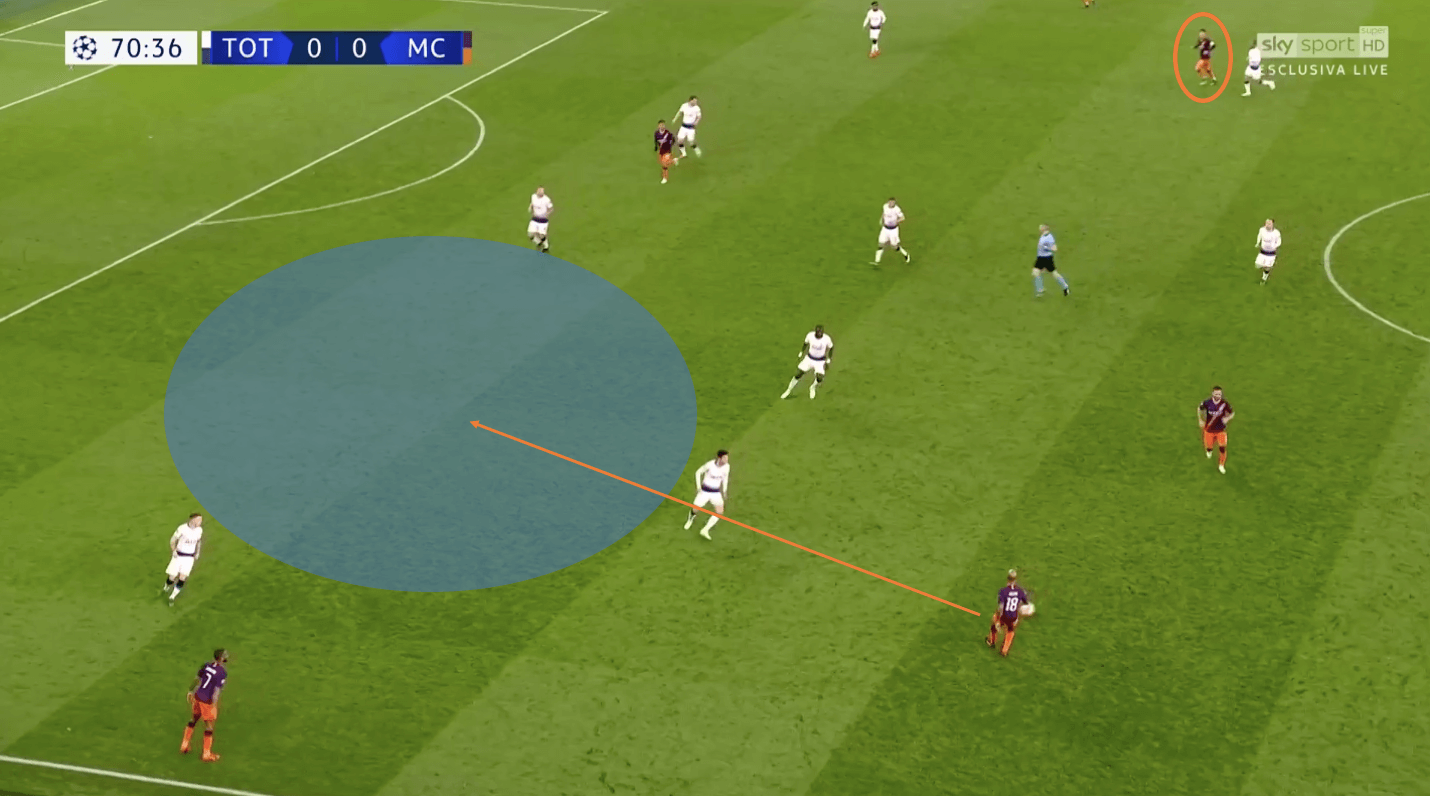
When Manchester City attack they usually work with a ‘five and five’ rule. Five players attack while five players hold and prevent counter-attacks. The usual attacking five are the central striker, two wingers and both the ‘free eights’. The defensive unit is then comprised of the remaining players.
In the game against Tottenham is was evident that City were attacking more conservatively to counter the threat of Spurs breaking on them. Instead of attacking with five players, they attacked with four and defended with six men behind the ball.
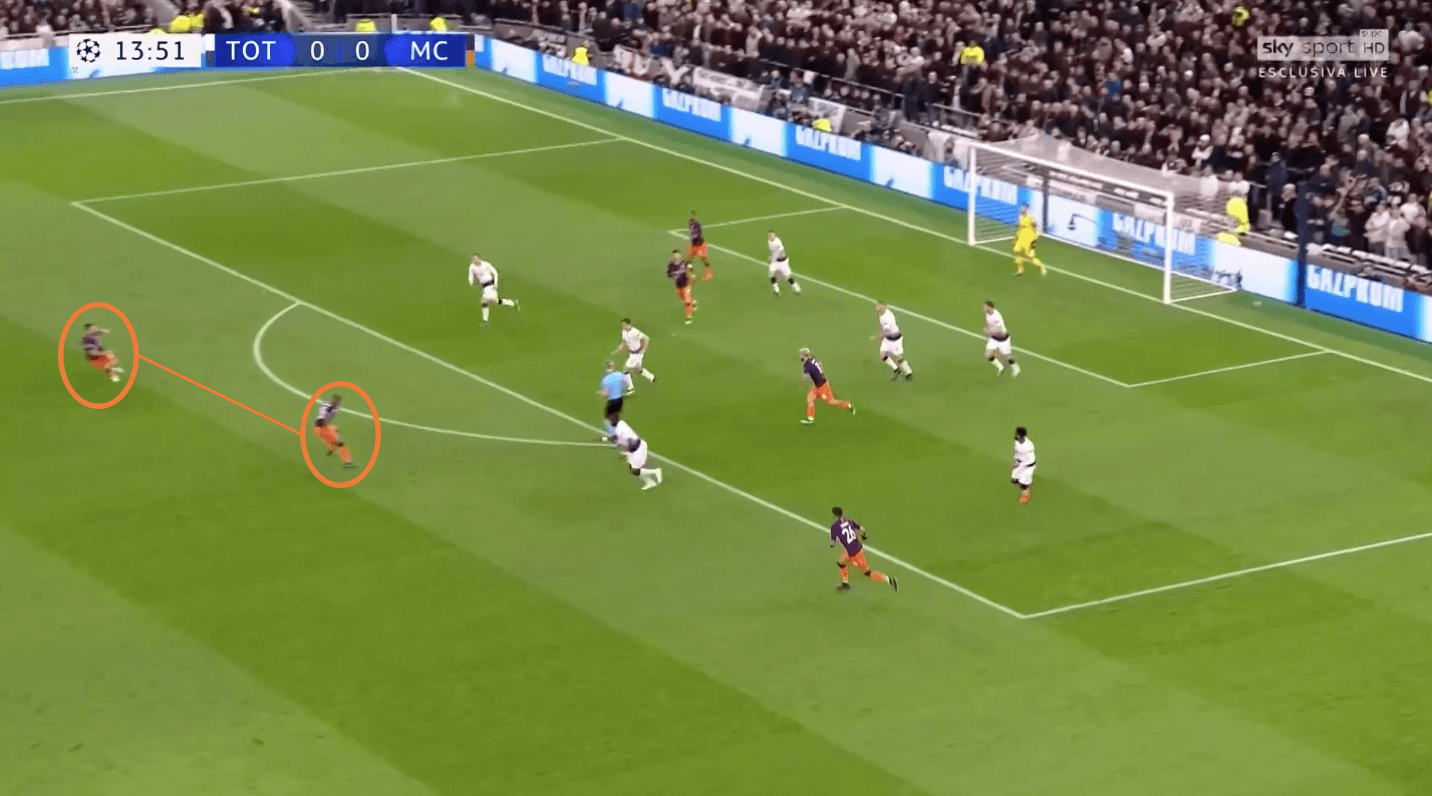
Above is an example where City had been attacking but have just turned the ball over. Circled are Fernandinho and Gündoğan. One can see how this makes Manchester City more defensively solid. It is easier to stop counter-attacks and recycle possession with six men behind the ball rather than five.
However, the trade-off for City was that their attack was blunted. On top of this, Gündoğan has scored a number of goals where he has ghosted into the box with a late third-man run. As he is being asked to hold a defensive midfield position, a lot of his goal-scoring threat is negated.
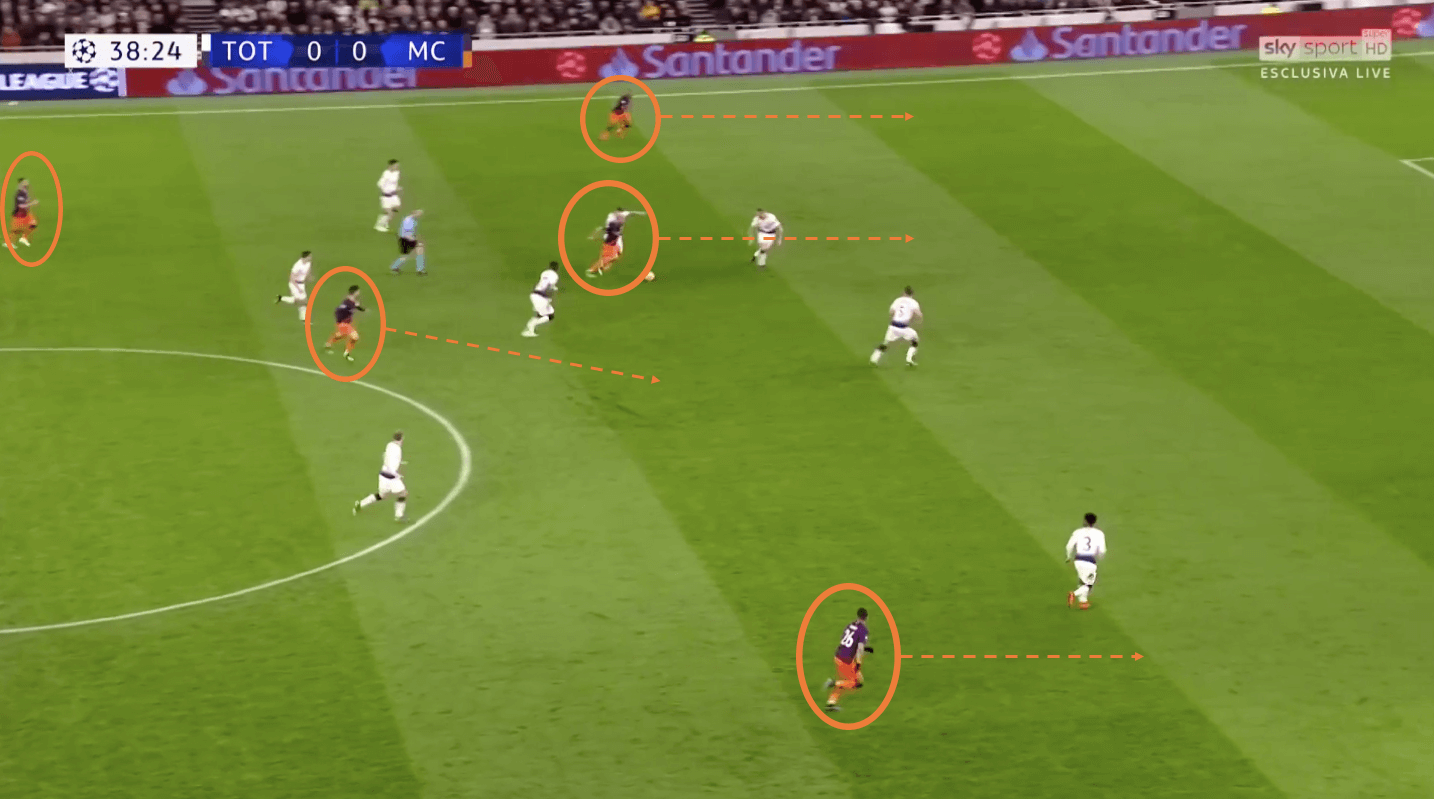
Above is a threatening counter-attacking situation for Manchester City just before half-time. Here we can see the split between the attacking unit of the team and the defensive unit. The four attackers are breaking their necks to get forward. Gündoğan on the other hand is clearly much more focused on the potential resulting attack from Spurs, and as such is much more reserved in his running.
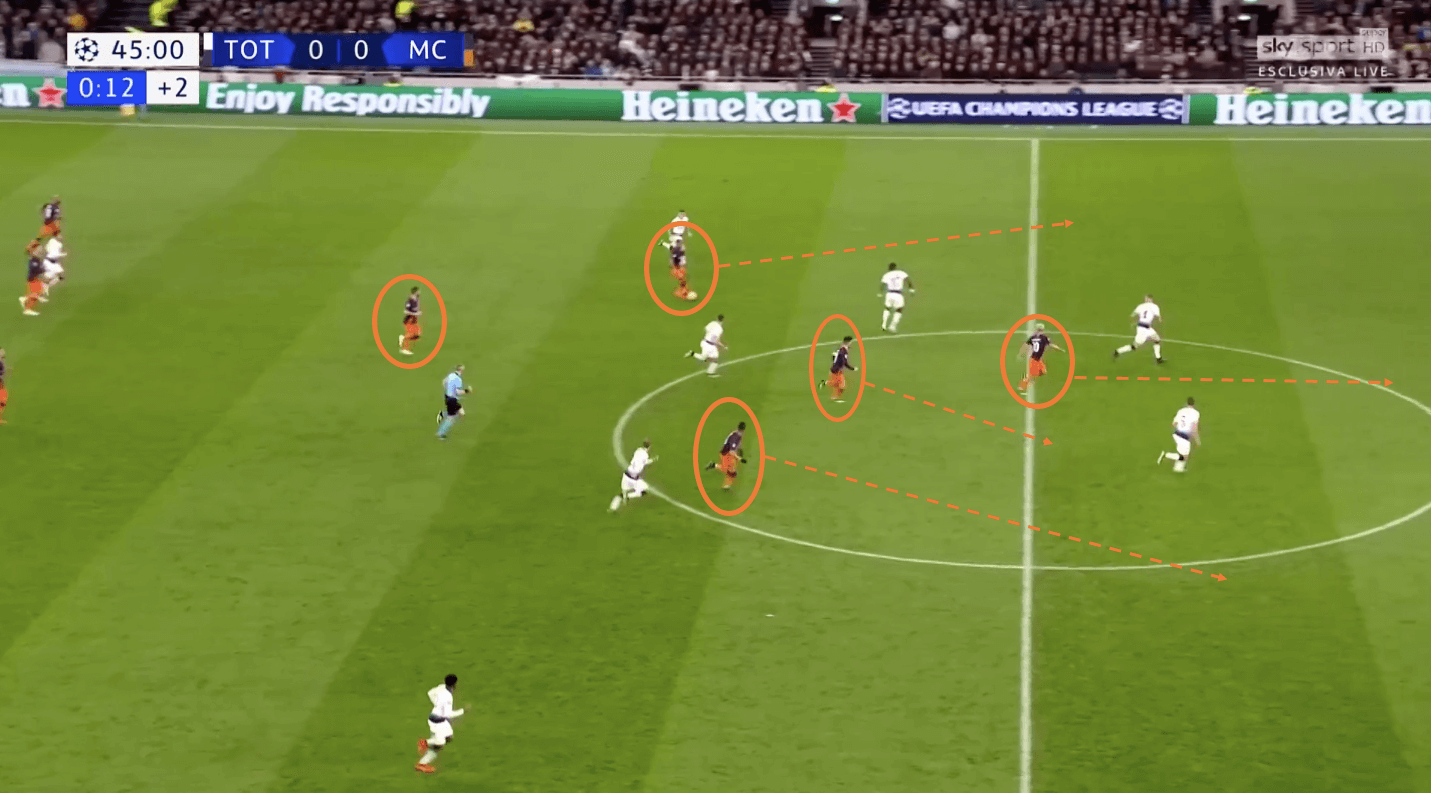
Another threatening situation is developing for City just a few minutes later. The four-man attacking unit is streaming forward. Gündoğan again holds a few yards behind to negate Spurs being able to attack should they win the ball back.
Tottenham defend the half-spaces
Tottenham were aware that Manchester City thrive when they can occupy the half-spaces in the opposition half. As such, they looked to minimise the space in which City could operate.
When City were building from the back, Tottenham employed a relatively high press. They pressed in their 4-2-3-1 shape with the attacking three of Heung-min Son, Christian Eriksen and Dele Alli supporting frontman Harry Kane.
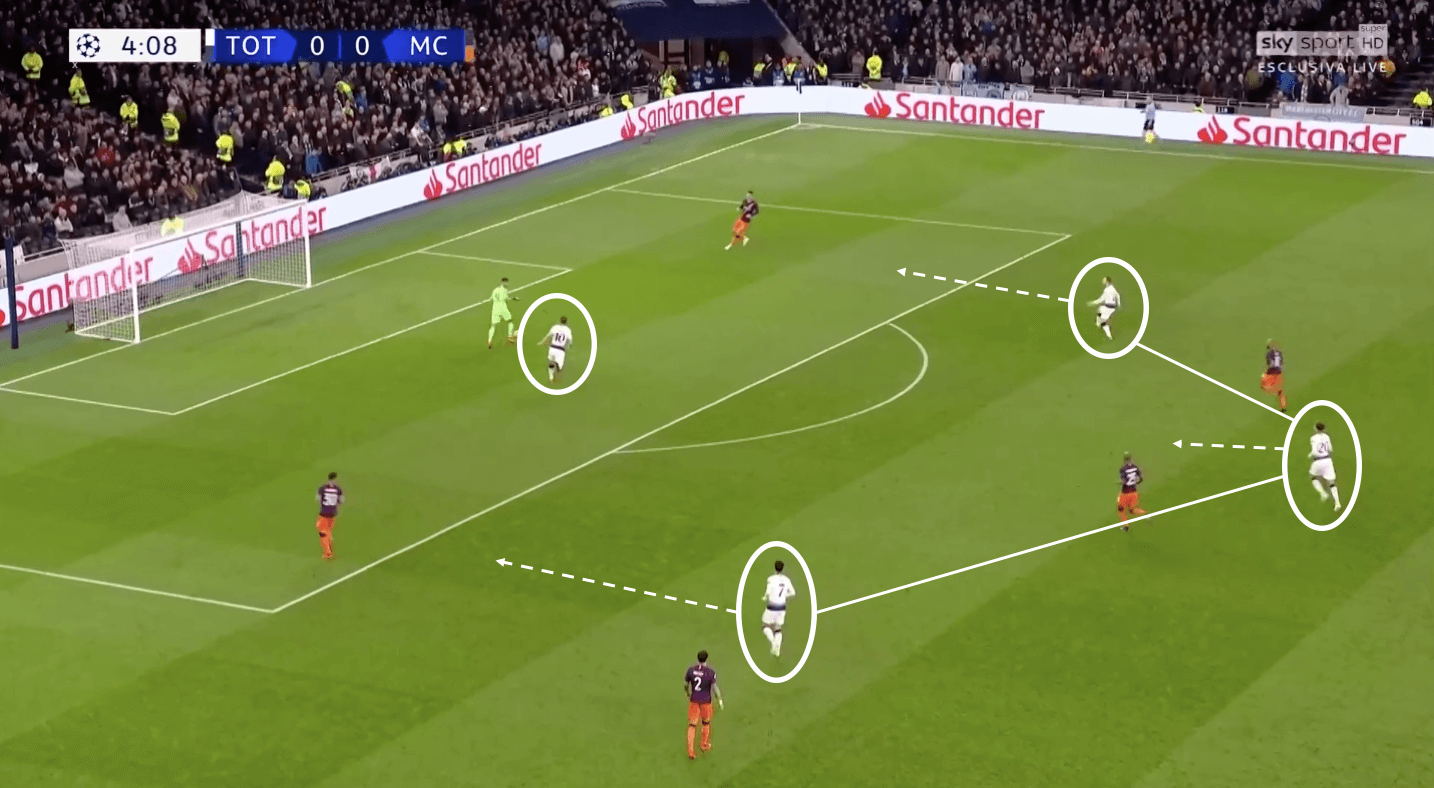
Above Kane arcs his run to prevent one of the centre-backs receiving the ball whilst also pressing Ederson. Son prevents either Kyle Walker or Nicolas Otamendi getting the ball whilst Eriksen moves to press Aymeric Laporte while also blocking the pass to Delph. Alli holds his position between the two central players and will press whichever one is the viable passing option.
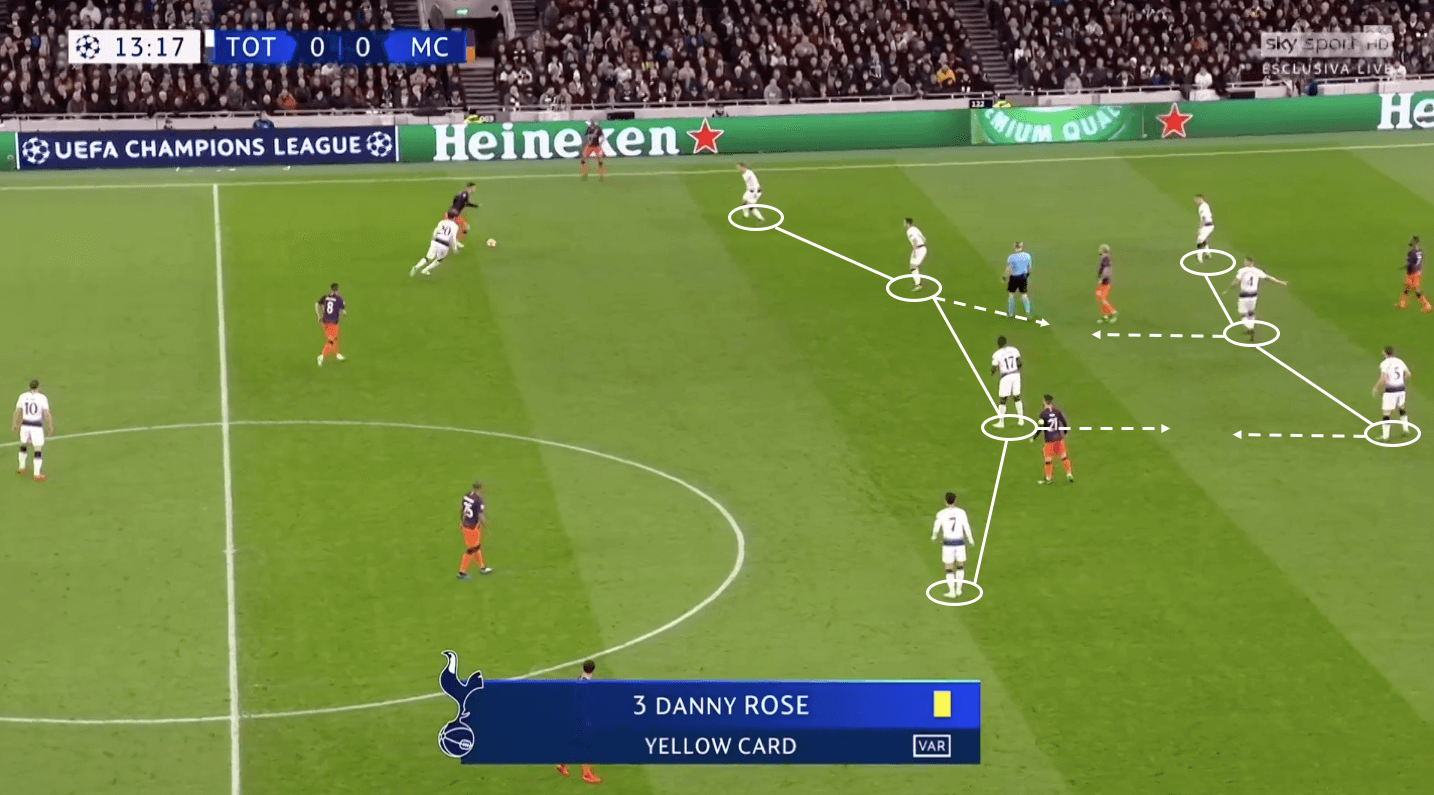
When Manchester City progressed the ball further forward, Tottenham’s line of engagement dropped. However, they retained a reasonably high line. They could afford to do this as City never really offered too much in behind. Raheem Sterling and Riyad Mahrez more often than not came to fight for the ball and Agüero was forced to drop deep to remain involved in the play.
With the line of engagement dropping and the defensive line staying high, Spurs massively decreased the space for City’s attackers in the half-spaces. Moussa Sissoko and Harry Winks were especially impressive in defending this area whilst Jan Vertognhen and Toby Alderweireld are both solid defenders when it came to defending on the front foot.
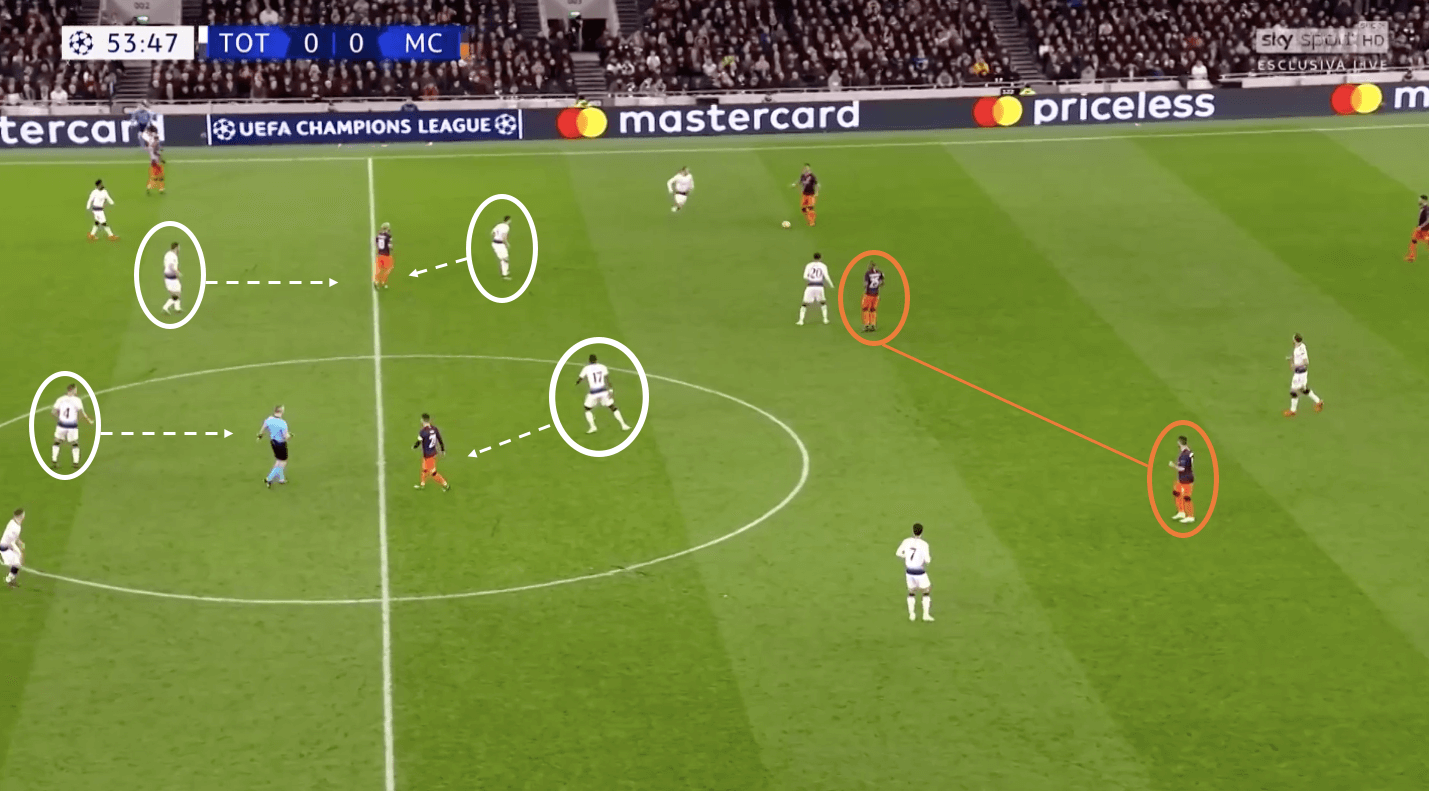
A similar example is shown above, which also highlights Manchester City’s issues in the 4-2-3-1. Agüero drops into a pocket of space to receive the ball as he is too isolated on the last line of defence. With no immediate danger around them, both Vertgonhen and Alderweireld can close the space between the midfield and attack. With pressure on the ball Winks and Sissoko can also drop and shadow press Silva and Agüero. City’s only real option is to play sideways and with a lack of penetration.
Final thoughts
In the end, the game was defined by fine margins. Fabian Delph’s lack of positional sense at the back post ultimately allowing Son Heung-min through on goal in the 78th minute. Had Agüero scored his penalty early in the game the narrative in this game could’ve been a lot more different
In football, much of the discussion following a game is based on the result. Manchester City were 12 minutes away from a 0-0 draw away from home in Europe; a credible result. What caused a stir was the fact that many feel that City are good enough to comfortably beat Tottenham.
Was Pep Guardiola too negative in his set-up? The answer to that could be yes. His defensive set-up stifled both Tottenham’s attack and his own side’s attack. Tottenham defended their own half well and prevented Manchester City from playing through them with much regularity.
The tie is finely poised and one could argue that Guardiola won’t be all that disappointed with that result. Pochettino will feel like his side will have to score at the Etihad whilst Guardiola will be confident City can turn the leg around with a 2-0 or 3-1 scoreline. However, the second leg is sure to be an exciting match-up.
If you love tactical analysis, then you’ll love the digital magazines from totalfootballanalysis.com – a guaranteed 100+ pages of pure tactical analysis covering topics from the Premier League, Serie A, La Liga, Bundesliga and many, many more. Pre-order your copy of the April issue for just ₤4.99 here, or even better sign up for a ₤50 annual membership (12 monthly issues plus the annual review) right here.

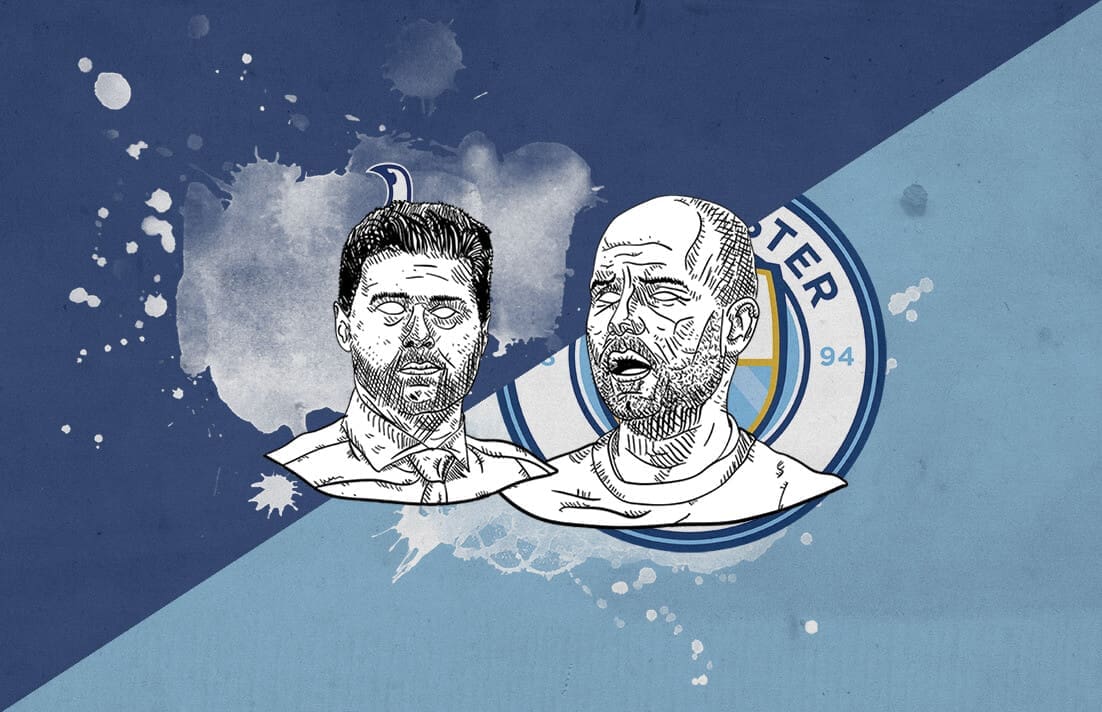



Comments